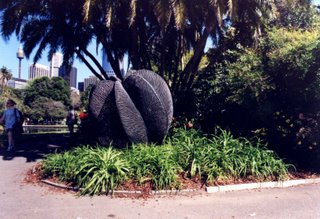A Bronwyn Oliver sculpture (Photo: The Artswipe)
Though I never met her, the death of Bronwyn Oliver - who on July 11, 2006, took her own life - came as a shock, and filled me with a deep sadness. Images of the Australian sculptor's work started appearing everywhere, and while I have been very familiar with her practice over the years, I started to scrutinise the work on a much deeper level. And I started to feel really, really sad, and filled with a loss that baffled me considering I had not given her work much thought in the past.
Writing in the Sydney Morning Herald - Spectrum (August 19, 2006) John McDonald rightfully claimed: "There is a terrible delicacy in writing about an artist who has recently taken her own life... Whatever one writes about the artist at this time will inevitably stand in the shadow of her death." I couldn't agree more. The intractable scrutiny I experienced in recent weeks while pondering Oliver's oeuvre, is that I find it difficult to shake off the impulse to find evidence, some clue pointing to the mysteries of why she took her own life. But all I find is that terrible, uncanny beauty that she so gracefully extracted from the soft folds of nature and transformed into hard-wired sculpture. It's a line of beauty that has overtaken me somewhat, forcing me to revisit all those artist-as-troubled-genius mythologies we're taught at art school to avoid.
I wandered into Roslyn Oxley9 Gallery on Saturday afternoon to check out Oliver's final solo exhibition and was delighted that the gallery was packed with so many people -- I actually can't remember the last time I visited a gallery with such healthy number of visitors at a time that did not coincide with the free booze of an opening night. I had been putting off visiting Oliver's show, even though it was my intention to pay my respects before the exhibition closed. But a part of me was a bit resistant to attending the exhibition because it would test whether my response to the work would be ideologically knee-jerking my critical faculties into blurring the line between an artist's life and their work. Could I put to the test whether Roland Barthes' "death of the author" argument actually worked when it came to the crunch? Much of the recent press about Oliver has focused on how intensely private, obsessive, hard-working and exact she was. Basically it seems Oliver was a big enigma in the artworld to those who knew the work but didn't know the person, because for starters she was rarely seen schmoozing at flashy Biennale openings and the like. (And I'm guessing most artists see more of each other at openings than they do their art. Unless of course checking out the stills of an artist's current exhibition on their dealer's website has become the equivalent of physically attending an exhibition).
Back to my point. It's precisely because Oliver was such a mystery that her work has been charged with a magnetic force that invites almost morbid speculation: Why did she do it? What could have been so terrible for her to do what she did? Such questions can never be sufficiently answered, so I reckon we should stop asking. But even if we do, it won't stop us from reading her work in ways that cannot but be divorced from knowledge of the death of this particular author. And in a sense that really depresses me. Because I wanted to think I could be more critical than that. I'm not saying Oliver's work doesn't deserve the praise. If anything, her work deserves so much more than our passing tributes punctuated with odd bits of nausea-inducing gossip about the circumstances surrounding her death. It is undeniable that Oliver was a brilliant artist and let's hope she will be admired for generations to come. Such a thought is somewhat optimistic because it means future generations viewing her work may elicit a necessary detachment from the work to set aside for a moment the "shadow of her death" and focus on the aesthetic, conceptual and technical wonders contained therein.
After attending the Roslyn Oxley9 exhibition, it dawned on me that I took a photo of one of Oliver's sculptures years ago -- I think it was 1999 or 2000 -- while doing a Sculpture Walk across Sydney. And while I remember at the time being pretty amazed by Oliver's achievement, the feeling of wonder passed rather quickly because ultimately like most of us I suspect, it wasn't attached to some romantic narrative of the artist's troubled life and death.


3 comments:
People all over the world suffer and die. Some with enormous talent, some not so… but the point is not that an artist has taken her life. It is more that she has left some thing behind… much more profound than any words could describe – the beauty and delicacy of organism.
The point is that an artist has taken her life, and the fact that people all over the world suffer and die does not diminish the actuality. The question is still 'why'. Is it because the relatively sane find it impossible to continue in a world where insanity is the status quo and any attempt to swim against the tide is too great a struggle against the odds?
who cares if she died?? noone knew her personally so what does it matter.. at least she lived her life while she was alive.. it was her choice to die not mine.. btw shout to Cozza-Lee heart u babe <3
Post a Comment